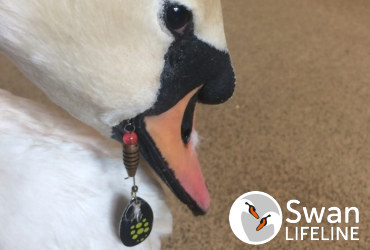Conservation Work
Swan Lifeline strives to create a better, healthier and safer environment for swans and general wildlife in the UK. We do this through local and national engagement, the sharing of information with other organisations, research and education.
Our staff have to be aware of an enormous amount of information on a daily basis, which puts the swans health and best interests first, ensuring nothing but the best care for swans that come into our care, but also enables them to deal with the members of the public involved in rescues and releases. There are many complicated laws on parliamentary statute governing the care and rules pertaining to the abuse of swans in the UK.
These laws allow the prosecution of a person who has knowingly abused a swan, its nest or its eggs.
To read the full version of the Countryside Act and specifically the law about swans, please click here.
Lead poisoning
In 1987, after we had established that lead was killing swans, we successfully worked with Richmond MP Jeremy Hanley to steer a private members' bill through Parliament banning the use of all but the largest and smallest lead weights. When Swan Lifeline began, the life expectancy of Thames swans was less than three years; mute swans do not normally start to breed until they are at least three years old. Our vet at the time, Steve Cooke, developed a treatment to neutralise lead in the swan's system, thus combating the poisoning. Now, following the removal of lead from the water and the conservation work of ourselves and others, the lifespan of Thames swans has risen ever since.
Hook and line injuries
We liaise with anglers and angling clubs to minimise these injuries amongst swans and water fowl. Regrettably there are still many unregulated anglers in the region. Many of the rescues we carry out involve these injuries and unfortunately with the emergence of online purchasing from abroad the size and type of hooks now being used by some anglers in the UK are posing a huge risk to the swan population. We are grateful to the clubs that support us with fundraising and education.
These photographs show the dangers posed to swans from hook and line injuries.


Research
We worked with the Regal Swan Group (USA) for a number of years on the causes of pink-feathering. Although the bacteria has now been identified, it is not yet known how this is transmitted to the plumage. With the help of the research team at Proctor and Gamble they were able to identify that Fairy Liquid applied to the feathers and washed through thoroughly enabled the feathers to return to their correct colouring and waterproofed condition after allowing the swans to dry and preen. There are still many swans in the Thames Valley, mainly in the larger flocks that have an element of pink feathering but unless this affects the buoyancy of the swan we do not intervene to clean them.
We work closely with our vet and all members of their staff to analyse, diagnose and treat some of the more unusual problems that swans present.
British Trust for Ornithology (BTO)
We work with the British Trust for Ornithology (https://bto.org), which has existed since 1933 as an independent, scientific research trust, investigating the populations, movements and ecology of birds. Swan Lifeline records birds admitted into care and previously unringed birds are ringed before release.
Our staff hold ringing licences with the BTO and all information is logged on a national database for reference. This enables us to discover the swans that are more “accident prone”, follow the progress of cygnets that have been in our care and be able to have a clear indication of the age of each swan and their preferred nesting sites.
Litter
Litter is a major cause of swan injury. We have seen many dreadful and unnecessary injuries caused to swans by the following:
Plastic bag injuries: the handles and the body of plastic bags can become entangled around a swan causing it to be unable to feed, swim or fly and at risk of starvation, drowning and attack.
Beer cans: both the plastic rings that hold a pack of cans together and the ring pulls themselves can become entangled around the beak and head of swans causing it to become unable to feed, swim or fly and as above, at risk of starvation, drowning and attack.
Balloons, kites, Chinese lanterns: these injuries are becoming more frequent. Helium balloons are especially dangerous as they do not break down in the water and the string can cause potentially lethal damage to swans. The strings from kites can become tangled around a swans body, head and beak causing the possibility of drowning.
Pollution
Swan LifeLine always informs The Environment Agency where there has been an incident of pollution in a waterway.
Instances involving the discharge of oil and other pollutants into waterways can have a devastating effect on the Swan population. Treatment and a return to health can take many weeks.
Pollution of waterways can be either an accidental or deliberate release of oil from boat engines to industrial accidents.
Education is an effective way to control the number of spills but there will always be cases where the perpetrator is neither interested nor cares about the effect their actions will have.
